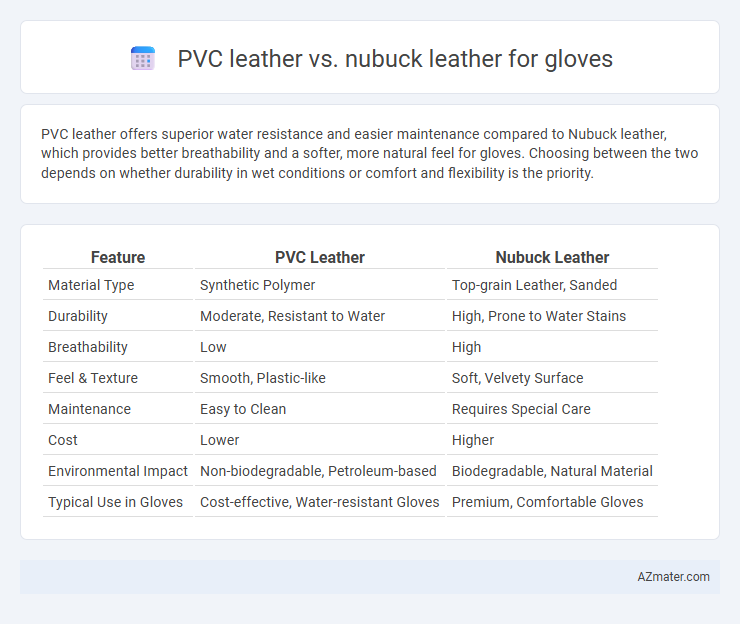PVC leather offers superior water resistance and easier maintenance compared to Nubuck leather, which provides better breathability and a softer, more natural feel for gloves. Choosing between the two depends on whether durability in wet conditions or comfort and flexibility is the priority.
Table of Comparison
| Feature | PVC Leather | Nubuck Leather |
|---|---|---|
| Material Type | Synthetic Polymer | Top-grain Leather, Sanded |
| Durability | Moderate, Resistant to Water | High, Prone to Water Stains |
| Breathability | Low | High |
| Feel & Texture | Smooth, Plastic-like | Soft, Velvety Surface |
| Maintenance | Easy to Clean | Requires Special Care |
| Cost | Lower | Higher |
| Environmental Impact | Non-biodegradable, Petroleum-based | Biodegradable, Natural Material |
| Typical Use in Gloves | Cost-effective, Water-resistant Gloves | Premium, Comfortable Gloves |
Introduction: PVC Leather vs Nubuck Leather for Gloves
PVC leather offers durability and water resistance, making it ideal for gloves used in wet or heavy-duty environments, while Nubuck leather provides superior breathability and softness, enhancing comfort and flexibility for prolonged wear. PVC gloves tend to be more affordable and easier to clean, whereas Nubuck leather gloves boast a luxurious feel and better grip due to their textured surface. Choosing between PVC and Nubuck leather gloves depends on specific needs such as weather exposure, budget, and desired tactile performance.
What is PVC Leather?
PVC leather is a synthetic material made by coating a fabric backing with polyvinyl chloride, creating a durable, water-resistant surface ideal for gloves. It mimics the look and feel of genuine leather while offering greater resistance to stains and abrasion, making it suitable for industrial and outdoor use. Compared to Nubuck leather, PVC leather is easier to clean and maintain, but it lacks the natural breathability and softness of animal-derived materials.
Understanding Nubuck Leather
Nubuck leather is a top-grain cattle hide that has been sanded or buffed on the grain side to create a soft, velvety surface with a slight nap, distinguishing it from the smooth, synthetic texture of PVC leather. This natural leather offers superior breathability, flexibility, and durability, making it ideal for gloves requiring comfort and tactile sensitivity. Unlike PVC leather, Nubuck's porous nature requires careful maintenance to prevent staining and water damage, emphasizing the importance of specialized care products for extended glove lifespan.
Key Differences Between PVC and Nubuck Leather
PVC leather is a synthetic material made from polyvinyl chloride, offering water resistance, durability, and affordability, making it ideal for gloves used in wet or harsh environments. Nubuck leather, sourced from the outer surface of cowhide and sanded to create a soft, velvety texture, provides superior breathability, comfort, and a premium aesthetic but requires more careful maintenance and is less water-resistant. The key differences between PVC and Nubuck leather gloves lie in their material composition, durability, water resistance, and tactile experience, influencing their suitability for various applications.
Durability Comparison: PVC vs Nubuck Gloves
PVC leather gloves offer superior resistance to water, abrasion, and chemicals, making them highly durable for heavy-duty use. Nubuck leather gloves provide excellent breathability and flexibility but are more prone to wear, stains, and moisture damage, reducing their lifespan in harsh conditions. For applications requiring long-lasting durability and easy maintenance, PVC leather gloves are generally the better choice.
Comfort and Wearability
PVC leather gloves offer superior water resistance and easy maintenance but tend to lack breathability, which can reduce comfort during extended wear. Nubuck leather gloves provide excellent softness and flexibility, enhancing comfort and allowing better airflow to minimize sweating. For wearability, nubuck adapts better to hand movements, whereas PVC may feel stiffer and less responsive.
Aesthetic Appeal and Texture
PVC leather gloves offer a smooth, uniform surface with a glossy finish that enhances a sleek and modern aesthetic, making them visually striking and easy to maintain. Nubuck leather gloves feature a soft, velvety texture with a matte appearance, providing a luxurious and natural look that develops a rich patina over time. The contrast between the synthetic, polished feel of PVC and the organic, tactile quality of nubuck defines their distinct sensory and visual appeal.
Maintenance and Care Requirements
PVC leather gloves require minimal maintenance, needing only occasional wiping with a damp cloth to remove dirt and prevent cracking, making them highly durable and water-resistant. Nubuck leather gloves demand more attentive care, including regular brushing with a soft brush to maintain the nap and applying specialized leather conditioners to prevent drying and staining. Proper storage away from direct sunlight and moisture is essential for Nubuck to preserve its texture and prolong glove lifespan.
Cost Effectiveness and Value
PVC leather gloves offer superior cost effectiveness, as they are significantly cheaper to produce and maintain compared to Nubuck leather gloves. Nubuck leather provides enhanced durability, breathability, and a premium feel, delivering greater long-term value despite a higher initial investment. Choosing between PVC and Nubuck gloves depends on balancing budget constraints against performance and aesthetic preferences.
Best Applications: Which Leather Suits Your Needs?
PVC leather gloves offer excellent water resistance, making them ideal for wet or chemical-handling environments, while Nubuck leather gloves provide superior breathability and flexibility, perfect for detailed work requiring dexterity and comfort. PVC's durability and ease of cleaning suit industrial and heavy-duty applications, whereas Nubuck excels in light-duty tasks, driver gloves, and fashion gloves where a soft, premium feel is essential. Choosing between PVC and Nubuck leathers depends on the balance between durability and comfort required by your specific glove usage.

Infographic: PVC leather vs Nubuck leather for Glove
 azmater.com
azmater.com